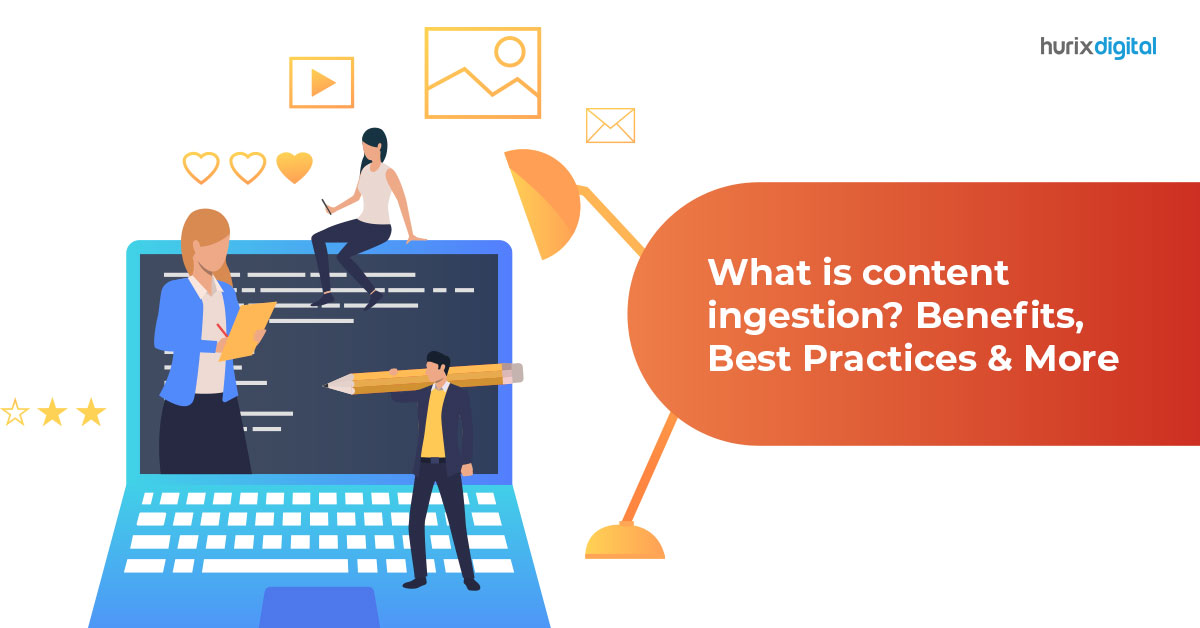
What is Content Ingestion? Benefits, Best Practices, and More
Summary
This article compares different ePublishing formats, helping you choose the best one for your content based on factors like flexibility, accessibility, and user experience.
Table of Contents:
- What is Content Ingestion?
- What are the Types of Data Ingestion?
- What are the Benefits of Content Ingestion?
- What are the Best Practices for Content Ingestion?
- How Can Hurix Help You?
What is Content Ingestion?
Content ingestion is a critical step in any content-centric process. It refers to importing large chunks of assorted content from various sources into a single, cloud-based storage system.
The consolidated content can then be accessed and analyzed from the data warehouse or database.
Content ingestion is a key process in any type of data analytics workflow, and every organization has to ingest content from different sources like CRM systems, email marketing platforms, social media platforms, financial systems, etc.
Since content can be in various different forms and originate from hundreds of separate sources, it is first standardized into a uniform format with the help of an extract/transform/load (ETL) process.
What are the Types of Data Ingestion?
There are mainly two types of data ingestion.
1. Real-Time Ingestion
In real-time ingestion, the content is collected and analyzed as it comes in. The data ingestion happens in real-time using cloud-based systems.
The content ingestion, in this case, is instantaneous, and the data is released to users almost immediately.
This method is suitable for capturing real-time metrics and trends. The main issue with real-time ingestion is that the type of analytics that can be performed in real-time is constrained.
2. Batch Ingestion
In batch ingestion, large amounts of content from several sources are first collected and then processed later. This is generally done on a scheduled basis.
This method is useful in situations where a large amount of data needs to be gathered before it can be processed, and there are no explicit time constraints.
However, this method can’t be used to provide real-time insights or immediate availability of content to users.
E-Book:
Hurix Mini-Book: Effective Training Techniques For Enterprises With Distributed Workforce
What are the Benefits of Content Ingestion?
Some smaller organizations may be cautious about implementing content ingestion as it can be a complicated and challenging process. However, it offers numerous benefits to businesses that one can’t afford to miss.
- Accuracy
Content ingestion ensures your content and the information you access are accurate, up-to-date, and reliable.
- Flexibility
Once the content ingestion happens, it becomes extremely easy to access, use, change, and analyze the data. Using raw data doesn’t offer these benefits.
- Speed
Having all your content sorted and stored in one place greatly speeds up the processing times.
- Efficiency
Content ingestion helps you load content into your system in a quick and easy way. This will save you a lot of time and energy as you can begin the analytics right away.
- Improved Data Quality
One major benefit of content ingestion is improved data quality. It provides you with accurate, well-documented content that you can use to make better decisions for your business.
- Identification of Errors in Content
The purpose of content ingestion is to make the content ready for analysis. While preparing the content, the ingestion process identifies errors and inconsistencies and helps fix them.
This is especially useful when your business deals with vast amounts of data.
What are the Best Practices for Content Ingestion?
Content ingestion is not just about collecting, analyzing, and organizing data. To get the best results, it is imperative to follow certain principles.
1. Automation
Automation is extremely significant when it comes to content ingestion. Human procedures are inadequate when it comes to dealing with such a high volume of data.
Automating the entire content ingestion process is recommended to boost productivity and save time. The entire process can be automated by using content ingestion tools that can help to improve the entire ingestion cycle.
2. Use Artificial Intelligence (AI)
Using artificial intelligence (AI) in content ingestion is a key practice no business should ignore. AI can be very useful when dealing with huge amounts of content collected from many different sources.
Using AI for content ingestion offers you many benefits, including:
- Enhanced security
AI tools help make your content more secure by identifying and flagging potential threats and malicious data sources at the earliest.
- Better accuracy
AI algorithms are meant to identify and repair errors and inconsistencies in content and help improve the overall accuracy of the data.
- Improved flexibility
AI-powered content ingestion is more flexible and can be adapted to changing data sources and needs. AI makes it easier to incorporate new content into your systems.
There are a variety of AI tools and techniques that can vastly improve the quality and efficiency of your content ingestion process.
3. Establish Idempotency
While designing the ideal content ingestion process, it is imperative to keep idempotency in mind. No matter how many times you execute the same process, it should be capable of producing the same results.
The process of data importing should be consistent and give the same result every time it is used in the content of content ingestion. Idempotency is important to ensure that the ingestion process can be safely re-run if something goes wrong without the fear of duplicate data.
You can establish idempotency in content ingestion by taking these simple steps:
- Use a unique identification code for each record to avoid duplicity.
- Use “upsert” operations to insert a new record or update an existing record without creating duplicates.
- Adopt a versioning system to ensure that you import only newer versions of records.
Establishing idempotency in your content ingestion process will save you time and effort in the long run by eliminating the need to manually identify and remove duplicate content.
4. Document Your Pipelines
Data pipelines refer to a sequence of data processing elements used in the content ingestion process. It is mandatory to document your data pipelines if you want to make the best use of content ingestion.
- Documenting your data pipelines gives you a better understanding of content ingestion.
- It makes it easier for everyone on the team to understand how the pipelines work.
- It makes it more convenient to troubleshoot and maintain the pipelines.
- Documenting data pipelines can serve as a reference for future projects.
How Can Hurix Help You?
Content ingestion is an integral part of all data-centric systems. Only an organization with long-term experience and expertise in information technology can help your business implement the best practices in content ingestion.
Hurix Digital has been an industry leader in the field of higher education and digital content transformation for over two decades. Get in touch with our experts at Hurix to understand your business’s content ingestion requirements and design a plan that is best aligned with your organization’s needs.
Also Read – Best Practices in Content Ingestion for Publishers

Passionate about developing innovative business models for customers in the content space. Primarily focused on the markets: US, UK, Europe, Middle East and APAC with 18 years of experience. Focused on collaborative working with internal teams such as Technology, Operations, Finance, and Marketing to ensure the voice of the customer is in everything that the company builds.




